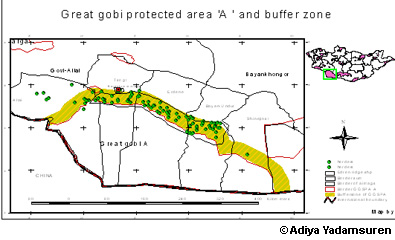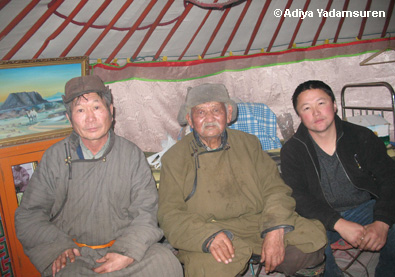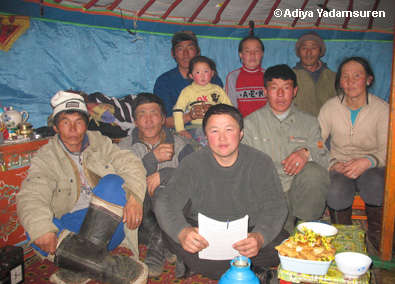Adiya Yadamsuren, our Mongolian Bactrian camel EDGE Fellow has just completed his surveys in the Buffer Zone of the Great Gobi Protected Area A in Mongolia. After a tough field session, braving extreme weather conditions and long cold days and nights, here is what he sent us:
Part 1
The Great Gobi protected area became a strictly protected area under the resolution of Chairman of People’s Great Khural in 1975. In 1995 it was included into Special protected area network by the 26th resolution of Mongolian Parliament as strictly protected area. Because of the untamed nature and endangered fauna and flora, in 1991 it registered into the Man and Biosphere network. The Great Gobi protected area has two parts as ‘A’ and ‘B’.
Great Gobi protected area ‘A’ is located in Trans Altai Gobi and it covers 45784.4 km2 (978.1km border) in area. According to administrative units, protected area exists on 5 small towns of 2 province (aimag) and is one of biggest protected areas in Mongolia. A total of 22.5 percent (31643km2) of Gobi-Altai province area encompass to the protected area including Altai which represents 48 per cent (8076.6 km2),Tsogt representing 48 percent (8076.6 km2) and Erdene which represents 62.4 per cent (15541.7km2). A total of 12.2 per cent (14002.6km2) of Bayakhongor province area encompass into it including Bayan-Undur which represents 49.4 per cent (8323.4km2) and Shinejinst which represents 34.3 per cent (5679.2km2) area each.

The north edge of the protected area is bordered by Edren Ridge mountain and this great ridge is located from northwest to southeast on three different small towns and two provinces and covers an area of 3678.3 km2. Edren ridge become main place for passing winter, spring and autumn with livestock. A total of 3678.3 km2 of the south part of Edren ridge mountain is included inside the protected area. Of this ridge, 17% (606.9km2 area) encompasses the Tsogt region, 60% (2215.1km2) encompasses Erdene of Govi-Altai province and 23% (843.9km2) encompasses Bayan-Undur of Bayankhongor province.
Mostly all of the boundary of the GGSPA is insulated by the Edrene range. Herders come and live in this Edren range from 15th November (Autumn) until to late of March (Spring). In the other seasons, this range has no herders and people. Summer time all herders move out of bufferzone to the mountains, about 40-200 km from boundary of GGSPA. In summer time the nearest herders live in small town is Bayantooroi village.This village located about 45 km from boundary GGSPA. Bayantooroi has a secondary school, small hospital and village government. Great Gobi Park Adminisration is also located here.
Herders and Domestic animals
In this survey we collected winter locations of herders in the bufferzone, number of famalies, population of livestock, information of number of camels eaten by wolf, number of hybrid camels, number of water holes and open waters in the bufferzone GGSPA ‘A’ region. According to our research results, there 114 families live that in Edren Ridge mountain and Khoid nuruu mountain during autumn, winter and spring time.
We counted those nomadic family’s total livestock. There were 2133 camels 35898 goats, 13246 sheep, and 348 horses. The life main source of income for nomadic families is livestock. Nomads devote all of the day to caring after their animals-watching over them, milking, shearing, or combing to produce felt and felt clothes. They also produce cheese and other dairy products around whole year. Especially they are living on livestock breeding and natural resources by following old traditions. Most of nomadic families sell their herd’s products such as camel wool, cashmere, skin and meat of goats and sheep in the small market of countryside. The money they make gets spent on rice and flour, other foods products and clothes.
This winter has been a terrible winter with too much snow from beginning of winter. However, it will become good source for growing grass and recuperating livestock in spring. All herdsmen are waiting for this time. We carried out some questionnaires with herdsman when they walk around pasture with livestock. Most of family’s members leave their ger (special Mongolian house) at sunrise to take their livestock out to pasture and then return back home at sunset. So sometimes, we had to wait for them in their home until the middle of the night to interview them…..
(To be continued…)

